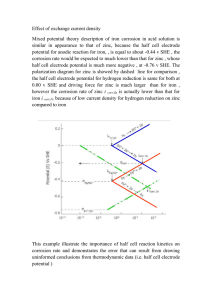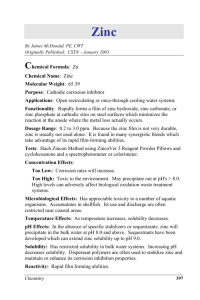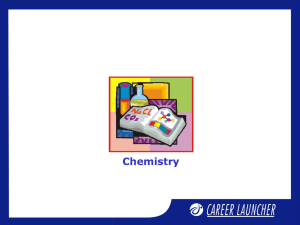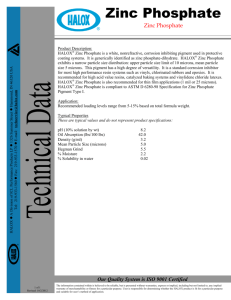Cathodic protection for boats ^ in saltwater
advertisement
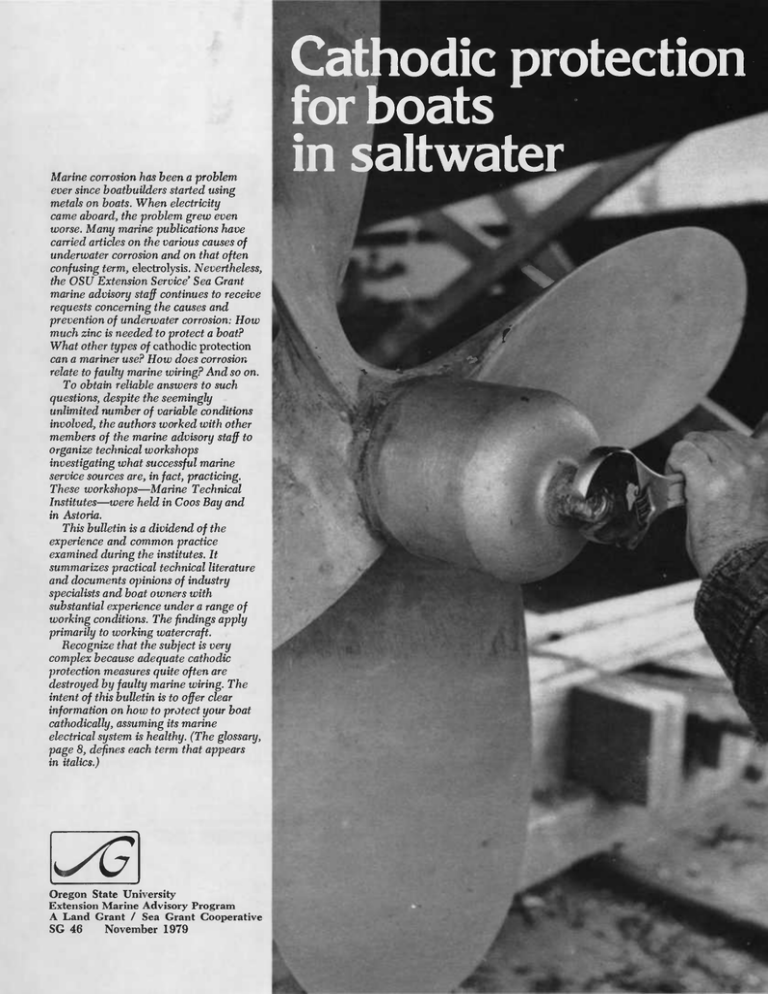
Marine corrosion has been a problem
ever since boatbuilders started using
metals on boats. When electricity
came aboard, the problem grew even
worse. Many marine publications have
carried articles on the various causes of
underwater corrosion and on that often
confusing term, electrolysis. Nevertheless,
the OSU Extension Service' Sea Grant
marine advisory staff continues to receive
requests concerning the causes and
prevention of underwater corrosion: How
much zinc is needed to protect a boat?
What other types of cathodic protection
can a mariner use? How does corrosion
relate to faulty marine wiring? And so on.
To obtain reliable answers to such
questions, despite the seemingly
unlimited number of variable conditions
involved, the authors worked with other
members of the marine advisory staff to
organize technical workshops
investigating what successful marine
service sources are, in fact, practicing.
These workshops—Marine Technical
Institutes—were held in Coos Bay and
in Astoria.
This bulletin is a dividend of the
experience and common practice
examined during the institutes. It
summarizes practical technical literature
and documents opinions of industry
specialists and boat owners with
substantial experience under a range of
working conditions. The findings apply
primarily to working watercraft.
Recognize that the subject is very
complex because adequate cathodic
protection measures quite often are
destroyed by faulty marine wiring. The
intent of this bulletin is to offer clear
information on how to protect your boat
cathodically, assuming its marine
electrical system is healthy. (The glossary,
page 8, defines each term that appears
in italics.)
^G
Oregon State University
Extension Marine Advisory Program
A Land Grant / Sea Grant Cooperative
SO 46
November 1979
Cathodic protection
for boats
^
in saltwater
Corrosion is one of the biggest
maintenance problems in vessels of all
sizes, particularly in saltwater. It costs
money, and it can cost lives if critical
equipment weakened by corrosion is not
replaced or repaired in time (figure 1).
Corrosion above the water line is one
thing; your only defense there is frequent
inspection and careful attention to
painting, cleaning, and greasing.
Corrosion of hull fittings and metals
below the water line, however, is another
matter. This you can control by cathodic
protection, and this bulletin describes
how you can achieve adequate
protection, using either zinc sacrificial
anodes or impressed current systems.
Corrosion is an electrochemical
process in which a chemical reaction
takes place, creating a flow of electrical
charge, or current, between two unlike
metals. This chemical action between
two unlike metals can destroy one of
the metals. When that metal is a
propeller, strut, or shaft, the damage can
grow expensive.
One cannot understand or design an
adequate cathodic protection system
without a basic knowledge of
direct-current (d.c.) electrical theory.
Ohm's Law is a handy starting point:
Briefly, it states that current (I) in a
circuit is proportional to the potential
difference (E) across a circuit. The more
resistance (R) in that circuit, the less the
amount of current. Ohm's Law can be
written mathematically as
potential (volts)
Current (amps) =
resistance (ohms)
E
or
I = —■
R
Figure 1.—Severe stray-current corrosion caused this kind of damage to a steel power cruiser.
Quick action saved this vessel from sinking because of hull perforation.
Connecting wire or bolt
r Electron flow
Zinc
I
Seawater
Copper
Zinc ions enter
solution (zinc
corrodes)
Copper is
protected
Figure 2a.—Current will flow between two different metals
in seawater that are connected together electrically.
Metal plate or fitting
Welded or bolted connection
///////////in/j////i/i/n//i/////n/n///i//////////i//////i/////////////nTn/{//i///iri
Electron flow
Side view of
zinc anode —'
Zinc ions
enter solution
Steel
mounting strap
Figure 2b.—A cutaway view of a zinc anode mounted to a metal plate or fitting.
In other words, given a certain voltage,
the lower the resistance, the greater the
current; the higher the resistance, the
smaller the current. The units of
electrical characteristics—current,
potential (another name for voltage),
and resistance—are defined as follows.
One ampere of current will flow through
a 1-ohm resistance when a potential of
1 volt is impressed across the resistance.
All electrical conductors have resistance.
Voltage is often compared to water
pressure. Then, the water flowing under
pressure through a pipe behaves like
electricity. The amount of water moving
through the pipe is analagous to the
current. The frictional resistance to water
flow within the pipe is the counterpart
of the electrical resistance. Most of the
discussion that follows relates to factors
on and around boats in saltwater (and
to a less severe extent, to those in
freshwater) that can reduce the
unwanted current that causes corrosion.
Types of corrosion
The simplest kind of corrosion to
understand and prevent is called galvanic
action; it occurs any time two different
metals are connected together electrically
and immersed in an electrolytic solution
such as seawater. (Salt dissolved in water
is an electrolyte; it makes the solution a
conductor of electricity.)
Figure 2a shows an electrical diagram
of galvanic action—a battery of sorts.
Figure 2b shows how this action occurs
on your boat. All metals tend to corrode,
but some do so more actively than others
—zinc, very much more so. In the
example, zinc is corroding and protecting
the copper by providing electrons
through the connecting wire to the
copper and preventing the loss of
electrons from copper.
The zinc installed to protect copper
fittings is said to be a "sacrificial
anode." Thus, a piece of zinc
that is attached to the boat corrodes
before the structural components do.
Another way to achieve protection is
with an external source, such as the
boat's battery, that-may also supply
electrons to the protected metal; this
method is the basis for the
impressed-current cathodic protection
devices. (See "Controlled voltage
systems.")
A second kind of corrosion,
stray-current corrosion, is often the
culprit when severe damage of
underwater metals takes place. In fact,
according to several marine electricians,
stray currents cause 90 % of underwater
corrosion problems. This kind of corrosion
can arise from many sources, including
faulty or inadequate wiring, either on
the boat or in the shore power connection.
All forms of underwater corrosion are
often referred to as "electrolysis," but
this label is widely misused. From a
troubleshooting point of view, it is
important to understand the difference
between galvanic action and
stray-current corrosion. The next sections
describe how you can protect your vessel
from both forms.
Preventing galvanic action
The commonest defense is the use of
zinc sacrificial anodes. The determination
of how many zincs to use, and of what
size, seems to be more an art than a
science. Many marine electricians decide
how much zinc to install by measuring
the potential of the hull relative to a
reference electrode hung over the side.
(Many skippers permanently mount
reference electrodes and monitor meters
on their vessels.)
Hull-potential measurement provides
a fairly scientific way to "zinc" a boat.
In this method, you simply add zincs to
the boat until the hull potential reaches
the desired value: for steel, about-0.85
volt versus a silver-silver chloride
reference electrode. The optimum
potentials for copper and aluminum are
about -0.65 and-0.95 volt, respectively.
Another method is to install zinc
anodes, then inspect to see if you
installed enough when you haul your
vessel out of the water after a year.
If the anodes are 50 to 80% consumed,
you have probably used the right
amount. The best summary of common
practice that the authors have been able
to assemble appears as table 1; it reflects
the amounts of zinc that representative
working boats are using and
knowledgeable service sources are
recommending.
The table presents a consensus of
recommended amounts of zinc for seven
typical boat sizes, based on technical
literature and on the experiences of
marine electricians, boatyards, and users.
These recommendations assume that the
larger boats have more underwater
hardware than smaller boats, such as
radio ground plates and keel coolers.
Note, too, that calculations of values for
table 1 are for a boat underway, rather
than sitting at the dock. The resulting
higher values apply more to work boats
than to pleasure boats.
Table 1.—Pounds of zinc recommended for boats underway
(water velocity of 5 knots or greater)9
Hull material
22-ft
Dory or
cruiser. 32-ft
32-ft
OB or Inboard Aux.
I/OB troller :sailboat
Wood or fiberglass
2-4
Steel or ferrocement 20-30
Aluminum
0-15
18-28
70-105
30-45
4-7
45-65
10-20
40-ft
Troller
48-ft
Troller
or
58-ft
combi- Combination nation
78-ft
boat
boat Dragger
40-60
110-165
55-80
50-75
65-100 105-160
160-235 230-345 405-610
80-120 120-185 225-340
* For the larger boats, this assumes use of 11.5-lb. rectangular anodes. Coverage assumes
typical conditions of speed, paint condition after 1 year, salinity, and no electrical problems.
For inboard vessels it also assumes copper alloy prop, ground plate, and keel cooler.
22.5-lh size
■5-Zfc size
The type, size, and mounting
procedure for zinc anodes are important.
Figure 3 shows some typical zinc anodes
manufactured by Federated Metals
Corporation. The 11.5- and 22.5-pound
(5.2- and 10.2-kilogram) sizes are
commonly used on larger boats, and the
5-pound (2.2-kilogram) and smaller
anodes are often seen on smaller boats
such as wooden trollers.
The most critical area for protection
on most boats is the propeller and shaft,
so it is natural that skippers usually
concentrate zincs in a vessel's stem. The
use of a zinc wheel nut cap or shaft
collar is common practice, and electrical
specialists highly recommend it. In
addition, anodes are needed on metal
rudders, bow irons, keel shoes, and any
other underwater metal fittings. Figure 4
shows recommended placement for zinc
anodes on a typical 65-foot (20-meter)
steel boat.
Figure 4.^Suggested placement of zinc anodes on each side of a 65-ft steel shrimper
(each bar symbol indicates one 11.5-lb anode).
Zinc nut cap (approx. 20 lb)
Figure 3.—Typical zinc anodes (photos
courtesy of Federal Metals Corporation).
It is important that anodes have a good
electrical connection to the metal they
are protecting. For this reason, the best
mounting systems use steel straps
imbedded in ("cast-in") the anode. You
then weld or bolt these straps to the
boat or fitting to be protected. Figure 5
shows what can happen if you use zinc
anodes without such cast straps.
Bolt-on connections require a good,
tight contact; sand the mating surfaces
with emery cloth until bright metal shows
before you bolt them together, then seal
the connections against seawater after
you tighten them.
Water seeps into joint between steel
washer and zinc anode. Resulting corrosion products create poor electrical contact.
wm
Steel washer
Zinc
anode
t Steel strap, hull or rudder
'- Paint or corrosion products
make poor electrical contact.
Figure 5.—this is what happens if your zinc anodes have no cast-in straps or inserts.
Factors influencing
the proper amount of zinc
There are a lot of ifs, ands, and buts
in the use of zinc. Remember that the
"correct" amount of zinc can vary
greatly, depending on your particular
boat, where and how you use it, and
other factors.
Overprotection. Unfortunately, it is
possible to "overprotect" a boat—to use
too much zinc on it—and actually cause
damage to the hulls of wooden or
aluminum boats. Overprotection can
endanger oil-based paint, too—even on
a steel boat. Modem steel boats with
epoxy or vinyl paint systems are
relatively immune to overprotection, but
paint bubbling can occur even with them
under some conditions.
The cause of this overprotection is the
hydroxide ions (the active ingredient
in caustic soda or lye) produced by the
electrochemical reaction on the surface of
the protected metal. These hydroxide
ions chemically attack wood, aluminum,
and oils.
Attack on wood is sometimes called
"wood electrolysis" and may show inside
the hull as a powdery substance near
through-hull fittings and other protected
metals. If you suspect that wood
electrolysis is taking place, taste a small
quantity of the deposit. If it tastes salty,
you are simply getting salt buildup
because of a leak. If it tastes bitter,
however, you are tasting lye—and you
probably have an overprotection
situation. You can remove lye deposits by
washing with distilled white vinegar,
but you need to deal with the cause of
the problem—too much zinc—
immediately. Aluminum is also attacked
by hydroxide ions, as pitting of hulls
underwater has demonstrated.
For these reasons, it is a good idea to
have a marine electrician measure your
hull potential, especially if you have a
wooden or aluminum boat. Hull-potential
monitoring is probably your best
insurance against both galvanic and
stray-current corrosion. In fact, most
experts recommend installing a
permanent hull-potential monitoring
meter and reference electrode.
For a small outlay of money, you can
buy portable equipment to measure hull
potential, but it is usually a better idea
to have this service performed
occasionally by an experienced marine
electrician or electronics expert. Most
active harbors have at least one person
available who can make this kind of
measurement.
Paint system. The condition of the
paint will greatly affect the amount of
cathodic protection current your boat
needs. A steel hull with a good paint job
needs far less zinc than one with old,
badly worn paint and bare spots. Users
of impressed-current devices with
ammeters see this effect: As the season
progresses and the paint wears, the
current drawn by the system steadily
increases; at haul-out time it can be
several times greater than at launching.
Water-flow velocity. Much more
current is drawn from the zincs when
your vessel is underway than when it is
moored (unless an a.c. stray-current
problem exists; see "Stray current
corrosion"). In fact, most of the experts
recommend smaller amounts of zinc for
still water than for moving water. The
amounts needed differ by anywhere from
two to six times. In still water, the
products of the electrochemical reactions
build up at the surfaces of the anode and
underwater metals and lower the voltage
of the galvanic "battery." As Ohm's Law
explains, the current is reduced.
Moving water rinses off the surface
products of the electrode reactions and
keeps the voltage of the galvanic
combination high. Then, as Ohm's Law
shows, the current is also higher. Vessels
that spend most of their time at sea or
moored in tidal flow areas need more
zinc than ones that spend most of their
time in still water.
Water salinity. Salinity affects the need
for cathodic protection; boats in saltwater
need a great deal more zinc than boats
in freshwater or brackish water. (The
resistance of freshwater is much higher;
therefore, the current flowing for the
same potential is lower.)
Purity of the anode metal. Zinc anode
material with more than about 0.005^
iron tends to form a scale over its
surface. Thus it corrodes poorly and
provides very little protection to a boat.
Melting down old zinc anodes and
casting new ones presents a risk of
introducing iron contamination. Some
remelted anodes work well; others do
not. To be completely safe, specify
anodes conforming to military
specification MIL-A-18001 H. Figure 6
shows what a properly corroding zinc
anode looks like.
Magnesium anodes are also available,
but magnesium is generally unsuitable
for marine use; the voltage it produces
in reaction with the protected metal is
too high—usually causing overprotection.
Special aluminum alloys have recently
come into use as anode materials;
however, for applications on small vessels
they are not widely available, and thev
have not yet been proven in service,
as have zinc anodes. Some aluminum
anodes contain mercury, and the
manufacturers caution against their use
in estuaries or inshore operations.
Bonding of boats. One final note about
zincs: You can achieve greater flexibility
by bonding—tying together electrically
all of the underwater parts of your boat,
using a heavy copper conductor (see
figure 7). Bonding is recommended for
all boats for a number of reasons, not
the least of which is suppression of radio
noise.
Bonding allows one zinc anode to
protect several fittings, as long as the
anode is of sufficient size. The only
really tricky job is bonding the propeller
and shaft; The film of oil on the gears
in the gearbox acts as an insulator. You
can solve this problem by using a shaft
brush, or you can leave the
propeller/shaft combination unbonded
and protect it separately with a zinc nut
cap or shaft collar.
Figure 6.—A properly corroding zinc anode: (above) a closeup of the anode; (below) a f idler
view of the hull area.
Figure 7.—The bonding system
Cooling water intake
— Radio ground plate
Stray-current corrosion
Sometimes a boat will experience rapid
corrosion of zincs and/or underwater
metal fittings, even while sitting at
dockside. When this happens, stray
current is probably the culprit.
In a d.c. system, stray current is
caused by faulty or inadequate boat
wiring. To keep on top of this situation:
1. Be sure your boat is wired properly,
using adequate wire sizes and well
sealed connections. It is also best to
use a negative ground system.
2. Be sure that all major metal
components, plus all metal
through-hull fittings, are bonded and
that the bonding system is tied to
ground (usually at the engine).
3. Be sure that exposed terminals or
other circuit components are not in
contact with seawater or
seawater-soaked wood.
There is another type of corrosion,
a.c. stray-current corrosion, but the
results are the same—disaster. When you
tie your boat into shore power in some
ports, the ground system may connect to
other boats' grounds through the neutral
side of the a.c. shore power on the dock.
Situations can arise that allow a.c. stray
currents to flow between your boat and
the dock or nearby boats.
To guard against these dangers, your
best defense is an isolation transformer.
As the name implies, such a device
isolates your boat's electrical system from
unwanted currents, but it allows a.c.
power to go where you want it.
There are other devices that can help
to prevent dockside electrical problems:
isolators, polarity indicators, reference
electrodes, and ground fault circuit
interrupters. Check with a marine
electrician about applying any of them
in your moorage.
Battery chargers—especially older,
nonisolating ones—can cause a.c.
stray-current corrosion; use only
UL-approved chargers. Some mariners
disconnect both terminals of the battery
as a precaution while charging.
Fortunately, an early warning system
exists for all of the problems listed above:
a hull-potential meter. Any stray currents
will cause erratic or abnormal readings
on a hull-potential meter. (Lost or
expended zincs also show up as a change
in hull potential—another good reason
for having a potential-monitoring device
aboard.)
Controlled voltage systems
Sacrificial anode systems consist of
zinc anodes that have a direct electrical
connection to the metal to be protected.
There are two cathodic protection
systems that operate differently:
"controlled zinc" and "impressed
current."
In the controlled-zinc system, you
connect the zinc anodes to the
underwater metals through an electronic
controller. This device continually senses
the hull potential (using a permanently
mounted reference cell), then
automatically adjusts the potential it
senses to the correct value. It does this
by varying the resistance between zinc
and protected metal.
Controlled-zinc systems are useful
primarily on wood and fiberglass boats.
Their advantages over zinc systems that
have no electronic controls are: longer
anode life, insurance against
overprotection, and a built-in meter that
continually tells what your hull potential
is. Disadvantages are: higher initial cost
and need to inspect the system
periodically.
Two manufacturers of controlled zinc
systems are:
Bartell Marine Electronics, Newport
Beach, Calif.
Electro-Guard Corrosion Control
Systems, San Diego, Calif.
A second controlled voltage system is
commonly called an "impressed-current"
device. It, too, uses an electronic
controller to sense and adjust hull
potential; instead of using zinc anodes
to make the voltage change, it draws
energy from the boat's batteries or
onboard power system. Current flows
through special nonsacrificing anodes,
instead of through zinc anodes.
Impressed-current devices are most
commonly used aboard larger commercial
vessels but are available for all sizes of
boats. They offer the advantages of
continuous protection without
overprotection, decreased maintenance
at haul-out time, no need to replace
expended zincs, and a built-in
hull-potential meter. The chief
disadvantage is high initial cost; others
are that you must pay close attention to
your monitor system and maintain a log
of performance and operating
characteristics. As your boat's battery
is in continuous use with an
impressed-current device, you must keep
it charged. One of these devices can
drain a battery in a few weeks!
Here are several manufacturers of
impressed-current devices (an asterisk
indicates an application limited to small
boats having outboards or stern drives):
Calpico, Inc., San Francisco, Calif.
Corrosion Control Associates, Richmond,
Calif.
Engelhard Industries Div. ("Capac"),
Union City, N. J.
Mercury Marine ("Quicksilver"),
Fond du Lac, Wis.*
Norton Corrosion, Ltd., Woodinville,
Wash.
Outboard Marine Corp. ("ECP Corrosion
Prevention Kit"), Galesburg, 111.''
Wilson Walton International, Inc.
("Aquamatic"), Hoboken, N. J.
Glossary
Cathodic protection—The practice of
protecting underwater metal parts by
connecting them to sacrificial anodes
that are more prone to corrode, or by
using an impressed-current device.
Conductor—A substance or body capable
of transmitting electrical current—
that is, having very low resistance.
Corrosion—The gradual destruction of
a metal surface through chemical
action.
Current—The flow of charge (electrons
or other charged particles) in an
electrical circuit. The unit of current
is the ampere or "amp."
Electrolysis—Traditionally, this term has
described all forms of electrochemical
corrosion, including both galvanic
action and stray-current corrosion.
Strictly speaking, it is the producing
of chemical changes by passing an
electric current through an electrolyte.
Electrolyte—A solution that contains
charged particles ("ions") and,
therefore, conducts electricity.
Electrons—Elementary particles having
a single negative charge.
Galvanic action—When two different
metals are immersed in an electrolyte
and connected together electrically,
either directly or by a conductor, a
current will flow from one to the other.
The metal more prone to corrosion will
corrode; the other will be protected.
This effect is called galvanic action.
Hull potential—The voltage of the hull
measured with respect to a reference
electrode.
Impressed-current system—a
cathodic-protection system that uses
a boat's battery as a source of current
to control the electrical potential of
underwater metals.
Insulator—A substance or body with very
high resistance, and thus a very low
ability to transmit electrical current.
Ion—An electrically charged atom or
molecule.
Potential—see Voltage.
Reference electrode—Voltages must
always be measured between two
points. The reference electrode serves
as one point for measuring the
potential of another object, the other
point—for example, underwater metal
fittings.
Resistance—Anything that impedes the
current flow in a d.c. circuit; the unit
of resistance is the ohm.
Stray-current corrosion—If a voltage
difference is accidentally impressed
on two underwater metal components,
one of them (the more positive one)
will corrode. This effect is called
stray-current corrosion.
Voltage (potential)—The driving force
for current flow in a circuit; the unit of
voltage is the volt.
Zinc sacrificial anode—A piece of zinc
that, when direcdy connected to an
underwater metal, protects the metal
from corrosion.
Corrosion control
Fundamentals of Cathodic Protection for
Marine Service, Society of Naval
Architects and Marine Engineers,
Technical and Research Report R-21
(New York, 1976). $7.50 from
SNAME, 74 Trinity PL, New York,
NY 10006.
LaQue, F., Marine Corrosion (New York:
John Wiley & Sons, 1975).
Mallon, Michael H., and Edward Kolbe,
Cathodic Protection for Boats in
Seawater: A Review of
Recommendations, Oregon State
University Sea Grant College Program,
Technical Report ORESU-T-79-003
(1979).
Woodcock, Karl S., Control of Corrosion
of Underwater Metals, State of Maine,
Department of Marine Resources
(Augusta, 1969). Available from
Department of Marine Resources,
State House, Augusta, ME 04330.
This bulletin was prepared by Michael H. Mallon, research assistant, Department
of Agricultural Engineering, Oregon State University, and by Edward Kolbe,
commercial fisheries engineer, OSU Marine Science Center, and assistant professor
of agricultural engineering, Oregon State University.
«M.
£
fio <M
Brand-name products are shown and
mentioned in this bulletin as examples only;
their depiction or mention does not constitute
an endorsement of these products.
For further information
Boat electrical systems and bonding
Kolbe, Edward, Using Multimeters,
Oregon State University Extension
Service, Sea Grant Marine Advisory
Program Publication SG 42 (Corvallis,
1977).
Miller, Conrad, Your Boat's Electrical
System (New York: Motor Boating
and Sailing Books, 1973).
to
OBEGOM STATE UtJIVEBSITV
£3 SF^
Extension Service, Oregon State University, Corvallis, Henry
A. Wadsworth, director. This publication was produced and distributed in furtherance of the Acts of Congress of May 8 and June
30, 1914. Extension work is a cooperative program of Oregon
State University, the U.S. Department of Agriculture, and Oregon
counties. Extension's Marine Advisory Program is supported in
part by the Sea Grant Program, National Oceanic and
Atmospheric Administration, U.S. Department of Commerce.
Extension invites participation in its activities and offers them
equally to all people, without discrimination.
